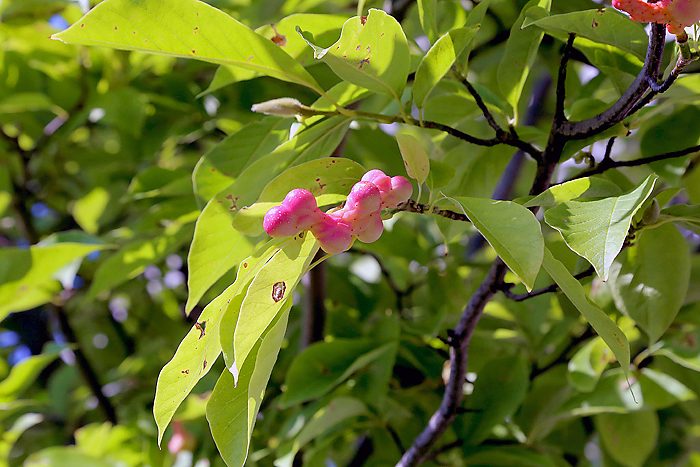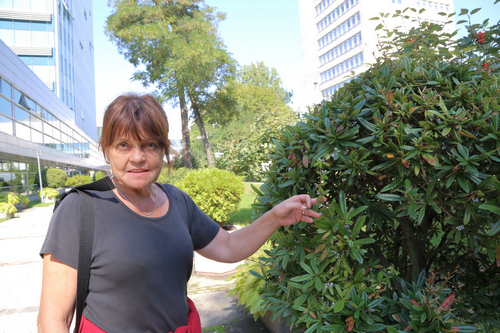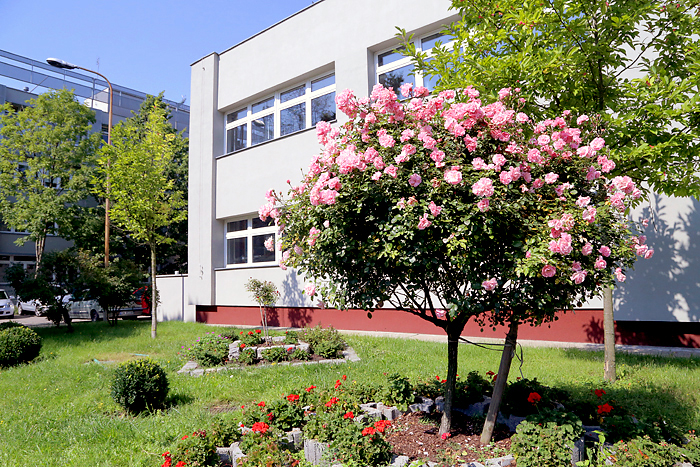She takes care of 87 ha
of green areas belonging to Wrocław University of Technology. She can talk about
plants for hours. Halina Lipińska is the only gardener employed by our University.
She started working for
Wrocław University of Technology in May 2008. “It was in the middle of the season.
To make matter worse, there was a drought. I was scared by the work I was to do.”
– she looks back to the beginning of her work for our University. “This is in my
genes.” – she jokes – “My grandfather was also a gardener.”
Halina Lipińska graduated from the Horticulture field of study at Wrocław
Agricultural University (currently Wrocław University of Environmental and Life
Sciences). Then, for a couple of years, she and her husband ran a horticultural
and seed farm (they grew tulips, for example). However, when the economic transformation
started in Poland after 1989, many of their clients went bankrupt or changed their
scope of activity. Then she sold the farm, and completed postgraduate studies at
Wrocław University of Economics and started working as an accountant. She participated
in many courses and trainings, gaining all possible certificates in the area of
accounting. “I always tried to take part in top level trainings.” – recollects Lipińska
– “I believe that if you decide to do something, you should do it well.”
Even when she worked as
an accountant, she still lived up to gardening. In the evenings, after work, she
designed gardens. “It also required some effort, the clients had very particular
demands, I had to learn all the time.” – she says –“But it allowed me to have a
rest from the accounting.”
And finally, in 2008,
she read an announcement that Wrocław University of Technology is looking for candidates
for the University gardener. She thought this is at last an occasion to combine
professional work with her passion. “I was so affected I missed the information
that they were looking for a man for this post.” – she laughs – “Uplifted, I ran
there and filed my application. And I was hired.”
Her friends often asked
what a gardener had to do in a technical university. They thought that for “technocrats”,
a piece of lawn and maybe a single tree would be sufficient. So did say, initially,
the administrators of some of the University buildings, who are also responsible
for the looks of the surroundings. “Maybe they were afraid of new tasks related
to the maintenance of flowers and shrubs.” – smiles the gardener – “At the beginning
I had to coerce them to allow me to plant a few almost maintenance-free flowers:
they only needed watering and weeding.”
Soon, the initial resistance
was replaced with competition – when the reluctant ones noticed that the neighbouring
area is beautiful and the effort required is not much greater, they also decided
to plant flowers. Lipińska started to plant flowers in many areas, choosing them
in such a way that all the time there was something in bloom at each place. Nowadays,
she plants over 1500 season crops. “In
a beautiful surrounding, you can work better.” – she emphasizes.
 1.
1.
She is very proud of her
collection of rhododendrons. It consists
of 9 species – from small to very large, blooming in various terms and colours.
On acid soil, she grows azaleas. She
also thinks about heathers and ericas,
but as for now, there is no place for them.
The beginning of the University
collection of canna lilies is interesting.
“Actually I didn’t plan to collect these plants.” – says the gardener – “But one
day, Andrzej from the utility section brought me one from home. It turned out it
was a very valuable variety with lemon-yellow leaves. I planted it between the A-2
and A-3 buildings. Then someone told me he had different varieties of canna lilies
with pink and red leaves. He brought a few cuttings. I planted them next to the
previous flowers and started to look for new ones. Andrzej simply incited me to
make this collection.
Other employees also brought
her occasionally cuttings or seedlings. “Then I often heard the question ‘how is
MY plant?’” – laughs Lipińska and adds that sage cuttings were grown at one of the
laboratories of Faculty of Civil Engineering. Sometimes, she also exchanges the
plants that she has too many for other species with other flower enthusiasts. “This
hobby is contagious.” – jokes the gardener.
 2.
2.
Next to the C-7 building,
there are Wintergreen barberries growing.
“It’s an evergreen, it only occasionally changes the colour of the leaves to yellow
or red. It has red fruit.” – explains the gardener – “One has to be careful with
the shrub, however, as it has long and hard thorns. It’s the plant’s defence mechanism.”
But Halina Lipińska is
especially proud of her Carolina sweetshrubs
with their specific strawberry-like scent. There are probably only three such plants
in Wrocław: two in front of the C-7 buildings and third at the University’s building
complex at Długa St. “I’m not sure if they can be found also in the Botanical Garden.
The closest that I have seen are in the Wojsławice arboretum.” – says Lipińska.
 3.
3.
Close to the bike park
at the C-13 building, she planted two Japanese
cherries. “As for now, they look rather inconspicuous but I can already imagine
how they will look in a couple of years.” – says Lipińska – “They will make a tunnel
of flowers over the alley.”
Before the main entrance
to the C-6 building, a rosewood tree
is blooming. “It’s a common rose that anyone can grow.” – says the gardener. But
the one grown by Lipińska has reached impressive measures. It blooms at least twice
a year. “The secret of this success lies in pruning the plant at an appropriate
moment.” – explains Halina Lipińska.
 4.
4.
“Now,
Wrocław University of Technology has the most beautiful green areas in the whole
city.” – emphasizes Lipińska – “I think we are even better than the Wrocław University
of Environmental and Life Sciences. But this success wouldn’t be possible if she
was to do everything on her own. 87 hectares is a huge terrain. Fortunately, building
administrators, employees of the utility section, and even area administrators and
charwomen help her. “My work consists in cooperating with all of them. The final
effect is a result of our common work. They often perform work that is not in their
scope of responsibilities.” – says Lipińska. She adds that gardening work (such
as fertilizing or pruning) must be performed in a strictly defined period. You cannot
postpone it for a week or month. “It’s really hard, physical work.” – she claims
– “We often dig in the ground with spades, even in sweltering heat, we get sweaty
and dirty, but then you can see the effects.” – she emphasizes with satisfaction.
Lipińska, already in Summer starts preparing for the following season: e.g. it’s
important to prune the shrubs and trees when they are not preparing for blooming.
In her leisure time, which is very limited, Halina Lipińska pursues her other hobbies – renovation of old furniture
and pontoon floating. When she was young she used to canoe along the Brda river,
although it was not a part of a national landscape park then and canoeing was considered
eccentric.
Asked
about retirement, she says she certainly won't be bored. “I only hope my health
will be OK.” - she adds. She is not concerned about what will happen then with the
University's “botanical garden”. „There will still be other people with passions.
And passions are contagious.” - she emphasizes.
Maria Lewowska, phot.: Krzysztof Mazur
Translation: Dariusz Więcławski
In the
photos:
1. Magnolia
fruit
2. Wintergreen
barberries
3. Carolina
sweetshrub flower
4. Rosewood
tree growing close to the C-6 building